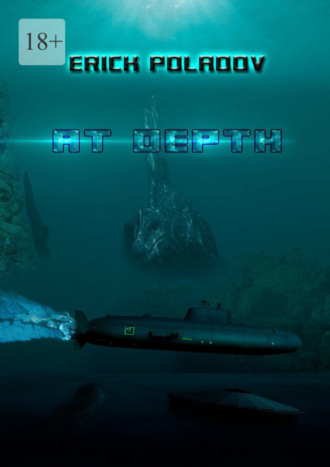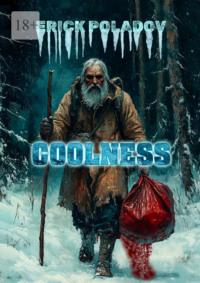
Полная версия
At depth
– And what can you say about this find? – Frost asked, pointing to the photographs.
– Judging by the structure of the skeleton, from the outside it looks like a mermaid. But it’s hard to say. Half of the skeleton is buried. – Taking a deep breath, Tucker returned to the main topic: – Well, okay. What is this expedition like?
– You dive into the waters of the Atlantic and follow a given route. Your responsibility is to use the manipulator to pick up all finds whose dimensions allow this to be done. Those, that are too large, you will need to carefully film with a drone, record the location coordinates and do a superficial investigation, resorting only to visual contact. In the future, if these finds are worth it, the company will take steps to bring such remains to the surface. We will entrust the study of them to the one, who discovered them. As for the timing, the voyage will last about two months, maybe another week, taking into account delays on site to study the finds. The amount due for your services is indicated on the back of the photo.
Tucker didn’t look at the back of the photo, but immediately asked:
– When are you planning to sail?
– In a few days the submarine will be launched into the water. Practical tests will be carried out for some time and, if the ship demonstrates itself in accordance with all the declared characteristics and everything goes according to the established plan, then the expedition will start in three months.
The scientist looked somewhere into the distance towards the ocean and said:
– You know, I could refuse, because there are enough remains of all sorts of prehistoric creatures on earth. But I’m already tired of studying dinosaur bones, and then, who knows, maybe in a place, where no one has ever been, there’s a much greater chance of finding something extraordinary.
After finishing his tirade, Tucker Hughes extended his hand to Frost. Frost shook it and said:
– I will be sincerely glad to our cooperation. And since you’ve already made your decision, I have to add something. You will need to arrive at your destination two weeks before departure. You will undergo a medical examination so that your body is ready for the dive; You will also have to undergo instruction in the operation of the submarine, which will become your home for two whole months, and a few other minor procedures. Do you have any questions for me?
– None.
– In that case, I will leave you my contacts…
– I’m afraid, Mr. Frost, it’s useless. You see, my colleagues and I are now facing an alcohol marathon, and by the morning I will no longer be able to find my pants, not to mention your business card.
Stephen Frost spoke in a serious tone:
– Mr. Hughes, I think you didn’t quite understand the essence of the whole situation. You will have to maintain a sober mind, because other people should not find out about our conversation.
The paleontologist lowered his eyelids in annoyance, and when he raised them, he said:
– Of course.
– That’s wonderful. I was sincerely glad to have our conversation.
On that note, Frost rose from his chair.
– Me too – Tucker answered, languidly shaking Frost’s hand.
The waitress immediately brought a glass of water and handed it to Frost.
Returning to the table with his colleagues, Tucker called the waitress and ordered a non-alcoholic beer.
– I don’t understand – Fernando said indignantly.
– Yes, Mr. Hughes – Jan supported. – We planned to relax.
Taking a deep breath, Tucker replied:
– That’s right, we wanted to relax. I don’t want to relax too much today and have my head tense tomorrow morning.
5. PREPARATORY BASE
His name in the company was known only to those who headed it. He always wore same clothes – strict suits in dark tones of black or gray. It is noteworthy that shoes, polished to shine, always matched color of a suit. Short-haired, clean-shaven and with a low, ringing voice. On his left wrist he always wore a watch from an elite brand, which he changed in the same way as his ties – separate ones for each day of the week. Everyone addressed him as «Mr. Smith» or simply «Smith». He was appointed curator of the expedition.
He provided the recruit with information about scientists, whose candidates, in his opinion, were most suitable in order to attract them to work on board the submarine. But his main competence is considered to be the ability to obtain, buy, extort and steal data from closed archives. Thanks to successful work in this direction, Smith made the upcoming expedition possible. With the information, that he managed to collect, diving into the depths of the Atlantic will not be pointless and, most importantly, will not be conducted blindly, but along a clearly defined route.
The day of departure was approaching. The stage of physical training of the crew was coming to end. Medical and preventive procedures were completed.
Late in the evening Smith visited the medical laboratory at the base, where crew members were being examined. He approached Doctor Kate Moore, who had finished reviewing the results of the examination of the last crew member several hours earlier. She was to accompany the crew as a staff doctor. At the age of thirty-eight, Dr. Moore firmly linked her future with medicine, sacrificing a family that she saw no point in starting if she had to disappear at work for twelve hours a day, and sometimes not leave the research institute at all for two or three days in a row. While working for one of the «Best Technologies» subsidiaries, Kate was asked to escort the crew of the submarine. The authorities approached her with a request. But Kate understood that it was better to agree right away, because she did not work for an ordinary pharmaceutical company. Here management provided unlimited opportunities, in exchange for which they had to adapt to local corporate ethics, which never takes into account the opinions of the staff, as all employees knew. Previously she had to monitor the condition of volunteers, who took part in experiments testing new drugs. Now the work ahead was much simpler and more boring.
Kate looked at the monitor, studying the results of the blood test. At this moment Smith approached her. Leaning over, he asked:
– Well, what about their health?
– In principle, everything is normal. Only Kayla Fox has a slight strain on her lungs. They are not working at full capacity. But this is not critical. I’ve already done two injections. In a week she will be as healthy as an ox.
– Is there anything else to come?
– No. I’m done.
– Do you remember everything?
– Saturday, twenty hours thirty-seven minutes, Heathrow, terminal six.
– Then see you soon – Smith said carefreely and left the laboratory for the psychoanalyst’s office.
– Ah, Mr. Smith – said sixty-five-year-old psychoanalyst Quentin Duff. – You’re just in time.
– So, – Smith said, as if drawing a preliminary line, – what’s wrong with our brains?
– Let’s go through it in order.
They sat down on the sofa and the doctor began going through the notes, while simultaneously talking about the results of the examination:
– Number one. Luther de Bont. Forty-nine years old. We may not particularly focus on it. I will only say that I would like to have the same nerves of steel. In the event of any emergency situation, he will maintain a cool mind and act rationally. I can say this with absolute certainty.
Putting aside the folder with the captain’s name, the doctor moved on to the next one:
– Number two. Morgan Sinclair. Thirty-seven years old. Senior mate. The captain himself found him. There is no doubt that it will withstand a long stay under water. The experience of serving on a submarine comes into play here. The candidacy is very good. He has well-developed phlegmatism. A situation that will not change for a long time is unlikely to throw him off balance. Let’s move on. Number three. Henry Mills. Forty-one years. Engineer. Your man.
– Yes. Ours – Smith confirmed. – How did he show himself?
– How should I say it? He is very interested in working with innovations. The time spent on practical tests was clearly not enough for him. He wants to watch longer how the submarine will behave. Has a quality that borders faintly on obsessive-compulsive disorder. In other words, he likes to check the same thing a thousand times. For example, if he closes the door before going to bed, then in five minutes he can check ten times whether he locked it.
– On the other hand, it’s good.
– Agree. With such a person, constant monitoring of the operation of the equipment will be ensured. Further. Number four. Hector Cage. Forty two years. Ichthyologist. There is internal depression against the background of labor dissatisfaction. Having changed his job, he stopped traveling around the world and studying rare species of fish. The new university does not provide him with such an opportunity. In this regard, he has high hopes for this expedition and is looking forward to its beginning. If negative energy accumulates, he will prefer to hold it in until someone is unlucky enough to meet him at the wrong time. But considering that he has not participated in marine fauna research for more than two years, his condition is quite suitable for diving. He will do his work with great zeal. So – sighing, Quentin Duff said, moving on to the next folder: – Number five. Kayla Fox. Thirty five years. Biologist. I must say, a very rare set of qualities. In her psychotype, such qualities as scrupulousness and pedantry emerge most clearly. But at the same time, curiously, she has some melancholic traits. Namely, a penchant for something creative. I wouldn’t be surprised, if somewhere in her home she’s conducting illegal experiments on growing some kind of centaur or alien. It is worth noting that she has a very valuable quality – she knows how to keep secrets. True, she can also store those that should be told to her superiors.
– Can she find something at the bottom and hide it from us? – Smith asked in a dubious voice.
– Considering, that she will have to work in a strictly limited space for a long time, I don’t think so. And then, she understands that in the future she can get permanent work with unique materials. So, it’s unlikely. Not in this case.
– Fine. Who do we have next?
– Sixth. Dr. Moore. I didn’t talk to her for a very long time. After all, we’ve been working together for several months now. I only asked about things that I couldn’t ask my colleague. Her general psychological portrait is quite transparent. There is only one weakness that can manifest itself during the swimming. She is not able to sit without work for a long time. In other words, if all the crew members are alive and well, then she will simply have nothing to do, and this in turn will affect her morale. Therefore, no matter how strange it may sound, healthy patients on board can become a problem for her.
Any problem can be solved – Smith thought instantly.
Duff continued:
– Ah! Number seven. The most interesting specimen. Tucker Hughes. Forty-five years. Paleontologist. Ready to work like a horse for months. But I bet that after finishing his long and fruitful work, he will boldly go to nearest brothel or tavern to remember the delights of life and fall into oblivion. It will also sound strange, but he is able to restrain his natural instincts and animal urges. My diagnosis: eligible.
– Wonderful – Smith concluded, shaking Duff’s hand.
Maintaining iron composure, Smith walked with a confident gait to the technical compartment. There he approached the only staff member and said:
– Connect me to the port.
– Got it – the engineer responded obediently. Having established a connection over a closed channel, he handed the phone to Smith.
As soon as the other end of the line answered the phone, the curator said only a few phrases:
– Smith says. No changes are planned. Everything is progressing strictly according to plan. The captain and senior mate must be at base by Friday. They will return with the rest of the crew at the scheduled time.
– Accepted.
– End of connection.
After a short conversation, Smith left the technical compartment. Having found the first free room, which turned out to be a warehouse with household equipment, Smith dialed the number from his mobile phone.
– This is Smith.
– Speak.
– Everything goes according to plan. But before diving you have to do something else.
– I’m listening.
– We need a pathogen.
– Which one?
– Mild, non-lethal, easily detected and quickly treated with standard medications. Several species with different incubation periods. The pathologies caused should not be transmitted to others.
– In what form should it be distributed?
– Through products.
– Deadlines?
– Thirty-six hours.
– I understand you.
6. «AMPHIBIA XXI»
At seven thirty in the morning Anguilla’s Clayton Lloyd International Airport was receiving a charter flight from Heathrow. After eleven hours of travel, the seven passengers were met by a thin man of average height, whom Captain De Bont, senior mate Morgan Sinclair and engineer Henry Mills knew well by sight. They called him Stanley. Whether this was his real name or not, they didn’t think about it. They met Stanley when they were conducting practical tests of the submarine. The others saw him for the first time. He was dressed like a typical resident of a resort town – a baseball cap with a curved visor, a loose shirt with multi-colored patterns and loose white trousers. All clothes were made of pure cotton. Stanley’s eyes were hidden behind wide sunglasses. If he took off his baseball cap from time to time when he found himself indoors, then even the captain, senior mate and engineer who spent three weeks with him during the tests did not know what color his eyes are.
Stanley helped load the travel bags into the trunk of the minibus. As soon as everyone was seated, he reversed and drove the car to the eastern part of the island, where an eight-seater seaplane was waiting at the pier. Stanley himself took the pilot’s seat. With a slight movement, he started both engines and began to pick up speed, developing it until the fuselage left the water, after which Stanley turned it towards the final destination.
Even before the seaplane began to descend into the water, an object located in the middle of the open water caught an eye through the porthole. Some kind of surface station had an impressive size, equal to two football pitches. Most of the area was hidden behind the roof, in the middle of which there was a sliding section with dimensions of twenty by forty meters. On the opposite side stood a control room with a radio tower and repeater. Another building was visible between them – a housing block. All three parts were connected by steel overhead bridges one and a half meters wide.
There was a pier along the perimeter on three sides. The seaplane stopped near one of them. Having moored the aircraft, Stanley led the crew along the pier towards the covered part of the station.
Finding themselves here for the first time, the scientists and the doctor looked around with curiosity. Through the glass windows in the control room, someone’s silhouette could be seen looming inside. Electronic locks were installed on the doors at the entrance to the housing block. The bridges, connecting the compartments, also had checkpoints in the form of lattice doors made of high-strength steel. On the side of the doors there were biometric locks with palm and retina scanners, as well as a microphone for voice reading and identification.
Stanley placed his palm on the panel and tilted his head closer to the retinal scanner. After a few seconds, the screen read: «Say «Picturesque bay».
Stanley said clearly into the microphone:
– Picturesque bay.
A signal sounded and the lock unlocked. Walking forward, Stanley held the door to let the crew members through. A few meters later, at the entrance to the covered part of the station, he performed the same actions, only this time, instead of «picturesque bay», the system required him to say «galvanic cell».
The full crew found themselves inside.
Stanley grabbed the switch, pulled it and the darkness was replaced by the glow of powerful LED lamps. An impressively sized surface hangar appeared before their eyes. Support underfoot was provided by only a quarter of the entire area in the form of a floor welded from a thick layer of steel, which was located along the perimeter of the hangar and had a depth of ten meters from the edge. All sorts of tools lay everywhere, including a welding machine, wrenches and adjustable wrenches, a grinder and a sharpening machine. Judging by the fact that only one of the many metal cabinets remained open, all these tools were used for some minor work, which, quite possibly, was carried out to eliminate minor defects. Somewhere at the far end of the hangar a manipulator was visible, which had obviously completed its work a long time ago. Two cargo boats were moored nearby below.
The views of all crew members, and especially those who arrived for the first time, were riveted on what was in the center of the hangar and was almost entirely hidden under water.
«Amphibia XXI» is an ultra-modern submarine, developed with the latest technology. The latest development of the «Best Technologies» company, representing the pinnacle of innovative achievements in the entire history of the company and a new milestone in global progress. The world’s only analog submarine capable of withstanding pressure up to eight hundred and fifty atmospheres, which allows it to reach almost maximum depths of the Atlantic Ocean. The displacement of Amphibia XXI when fully submerged under water is two thousand one hundred and fifty tons with a length of thirty-five meters. Equipped with a nuclear reactor and four engines, Amphibia XXI is capable of reaching underwater speeds of up to thirty-five knots and maintaining navigation autonomy for up to one hundred and ten days. Operating at the expense of a reactor, the submarine has on board an installation for autonomous generation of oxygen reserves. Thanks to a well-functioning system of equipment interconnection and centralized access to its management, the minimum number of crew required to maintain and operate the submarine is only three people.
Having passed all practical tests under the command of captain Luther de Bont, Amphibia XXI stood idle in the private bay located eighteen kilometers north of Island Harbor awaiting the start of its mission. So far, the only thing that could be seen above the water, was the top of the wheelhouse and the entrance hatch. The rest of the hull was hidden under water and what the actual dimensions of the submarine were, the ichthyologist, biologist, paleontologist and doctor could only guess.
Captain De Bont hit a button on the dashboard in the wall with his hand, after which a collapsible ladder began to extend from under the floor. The crew members followed it to the center of the hangar. The captain opened the entrance hatch and was the first to go inside the submarine, taking the others along with their travel bags.
Stanley remained upstairs. Or left the hangar. However, this was no longer important. The last stage of preparation remains before the start. All crew members had to quickly get used to life on a submarine. While this was a common occurrence for Captain De Bont and his senior mate Morgan Sinclair, and engineer Henry Mills managed to take his first steps, the rest of the crew needed some time to get used to the new environment.
– So, ladies and gentlemen, – Captain De Bont said, sighing loudly and spreading his arms wide, – let me give you a tour. Me, Morgan and Henry have already gotten used to it a little, but for you at first everything will be new. Follow me.
The captain elegantly turned around on his axis, beginning the briefing:
– This room is called the «central post». It is from here that we will control our beauty. Frankly, when they first brought me here and showed me this miracle of engineering, I was stunned. On a standard submarine, you have to have a whole group of specialists to simply correct the position of the boat. And here, using just keys and touch panels, you can manipulate all systems while sitting still. Add here some military equipment with shells, and there would be no price for such submarines in the military flotilla.
– Why «Amphibia»? – asked medic Kate Moore.
She immediately turned around when she heard Henry’s voice behind her, who answered the question posed:
– Some people believe that at the bottom of the ocean there is a completely different environment, which is very different from the sea we know and hides something new, previously unknown to mankind. There is also water there, but not at all the kind we are used to. And our Amphibia is heading exactly there.
– So, it turns out that you are one of those who built this boat?
– Something like that. I was the senior assistant to the chief designer.
– Why didn’t he go on the voyage?
– He is sixty-nine years old. He is too ancient for such walks.
The captain, meanwhile, continued to introduce the scientists to the central compartment, pointing to the chairs in front of the monitors:
– These are your jobs. Here, through monitors, you will watch what is happening in the ocean outside. There are cameras with spotlights throughout the submarine’s hull, so be careful and try not to miss anything. Please go to the next compartment.
Luther de Bont led the crew through a rectangular partition hatch into the next room, where he drew attention to the entrance to the compartment with the inscription above the entrance «biological laboratory».
– Miss Fox, this is your abode. Here you will perform your immediate responsibilities. Everything you need is here – a refrigerator, containers with liquid nitrogen, microscopes, a chamber with a vacuum pump, a centrifuge, all sorts of chemical liquids, tools. In general, you will understand. Now I ask you to go to the next compartment.
The room was equipped with an abundance of instruments for comprehensive measurements of parts of a skeleton, scales, tools for cleaning skeletons from dust and foreign substances, a computer with a database that stored information about all living beings on the planet, not only living today, but also ever lived.
– As you already understand, Mr. Hughes, this service bungalow is assigned to you. But I think you’re familiar with everything here, aren’t you?
Dr. Tucker Hughes nodded silently, carefully examining the room allocated for his work.
The next compartment belonged to Hector Cage. The difference between his computer and Tucker’s was that here on the hard drive there was all the detailed information about representatives of the fauna that live and once lived not only in the vastness of the ocean, but also in the aquatic environment anywhere on the planet, including rivers, seas and lakes. In addition, along two walls in the shape of a square there was a huge aquarium made of a high-strength alloy of glass and plastic, divided into thirty-four sections of different sizes. There was a control panel on the wall. Using it, by pressing one key, it was possible to open the inlet valve and fill a section with a specific number with water from the ocean through a system of hoses, the holes of which were led out through the hull of the submarine. In the same way, it was possible to pump water out of a specific section using a second tube that was connected to the drainage system.
The next compartment housed the infirmary. It was one of the most spacious rooms.
– And we will come here to complain to Dr. Moore about our health. But let’s hope that this cruise will take place without incidents and everyone will be as healthy as animals.
After an interim pep talk, Captain De Bont pointed out to Dr. Moore that there were two isolation rooms in place should anyone need to be kept away from the rest of the crew to avoid infection. On the back side there were cabinets and refrigerators with medicines, medical equipment, materials and other supplies. The infirmary was also equipped with the most advanced technology, including several microscopes, including electronic ones; pneumatic syringes, x-ray, transformable surgical table and ultrasound machine.






